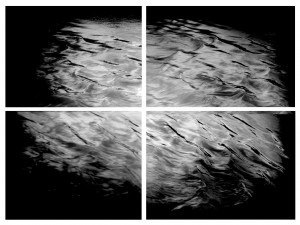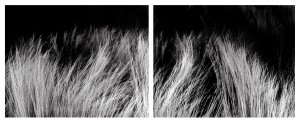Tags
Related Posts
Share This
Honoring Miller’s Legacy
Steve Paxton’s worst memory of Steven Miller is “when his dog vomited in Benildus.” Otherwise, “He prepared the most thoroughly of any college professor I have ever known,” Paxton says.
Miller, former department chairman of the Contemporary Music Program, is dying of amyotrophic lateral sclerosis, or ALS—sometimes referred to as Lou Gehrig’s disease.
Paxton is Miller’s direct successor as department chairman, and while reflecting on Miller’s work as a faculty member he says, “His…seriousness about teaching was astounding and inspiring.”
Friday, Sept. 26, a benefit reception was held in Miller’s honor. With Paxton’s assistance, the Critical Space Gallery of the Visual Arts Center at the Santa Fe University of Art and Design became an aural photo album where one could experience, rather than merely view, a re-installation of “Along the Pecos”—a collaborative piece by Miller and photographer Jennifer Schlesinger Hanson.
“When I think of Steven now, and especially in re-installing this exhibition, I keep being reminded of how intelligent and creative he is,” Hanson says. After learning that his illness had taken a turn for the worse, Hanson, a CSF alum, wanted to create a space in which those who know Miller (and those who don’t) could honor him and his achievements.
Originally installed in 2008, “Along the Pecos” is a multimedia exhibition combining an audio composition of sounds, recorded by Miller in the Pecos wilderness, and toned gelatin silver prints from Hanson’s “Earth Series.”
“The point is to be transported,” Hanson says, “as though you were sitting outside on a warm summer night listening to the composition of the river, and looking at your surroundings by moonlight.”
Hanson’s prints “present natural forces such as water, wind and light through abstractions of familiar patterns found in nature,” e.g., the surface texture of water, or the arrangement of pine needles on a branch.
The viewer, sitting in the middle of a darkened room, is meant to observe them by spotlight while Miller’s composition fills the room’s negative space, and fructifies the dead air with the “sonic diversity” of the Pecos River.
Miller conceived the idea in 2004, according to Hanson, and then approached her about adding Hanson’s photographs. Four years after the original exhibition, Everglade Records published the installation in DVD format.
Though “Along the Pecos” was their only collaborative piece, Hanson recalls the pleasure of working with Miller, saying, “Steven had a vision…he trusted me, and I trusted him…[he] was never demanding or dictating, he just allowed for the intuitive process of our own work to meld together.”
But reinstalling the exhibit last week wasn’t as natural for Hanson as her synergy with Miller.
“The biggest challenge,” Hanson says, “was blocking out the windows, having white walls, and poor lighting.” As a result, the catalyst for singularity of focus on each image was lost, watering down the aural affect of Miller’s composition.
However, “The point was to get it up in time for Steven to know it was happening”—before the worst could happen.
And so, over the course of five days, Hanson did—raising more than $500 for Miller’s family.
“It was good to have it up, and be able to invite people and curators…to view it,” Hanson says. She’d like to find a “permanent home for the exhibition,” and believes the reinstallation has “drummed up some potential interest.”
But in the meantime, “Along the Pecos,” for Hanson, not only personifies the “visceral experience” one may have with the river, but another piece of Miller’s legacy.
“He really is an artistic genius, and I’m honored to have had the opportunity to work with him.”








 Jackalope Magazine is the student magazine of Santa Fe University of Art and Design. Building on the interdisciplinary nature of our education, we aim to showcase the talent of our university and character of our city.
Jackalope Magazine is the student magazine of Santa Fe University of Art and Design. Building on the interdisciplinary nature of our education, we aim to showcase the talent of our university and character of our city.
Recent Comments